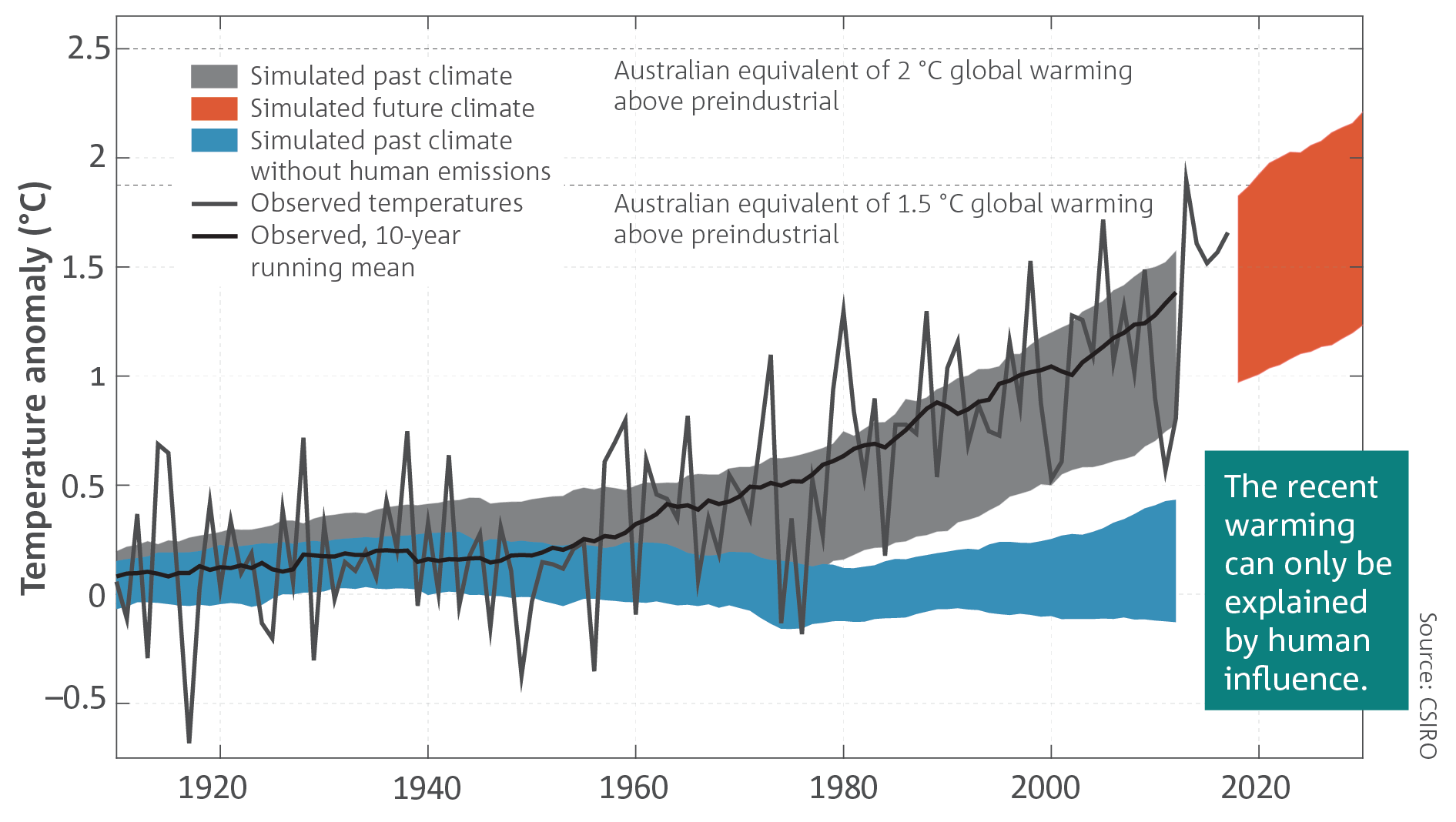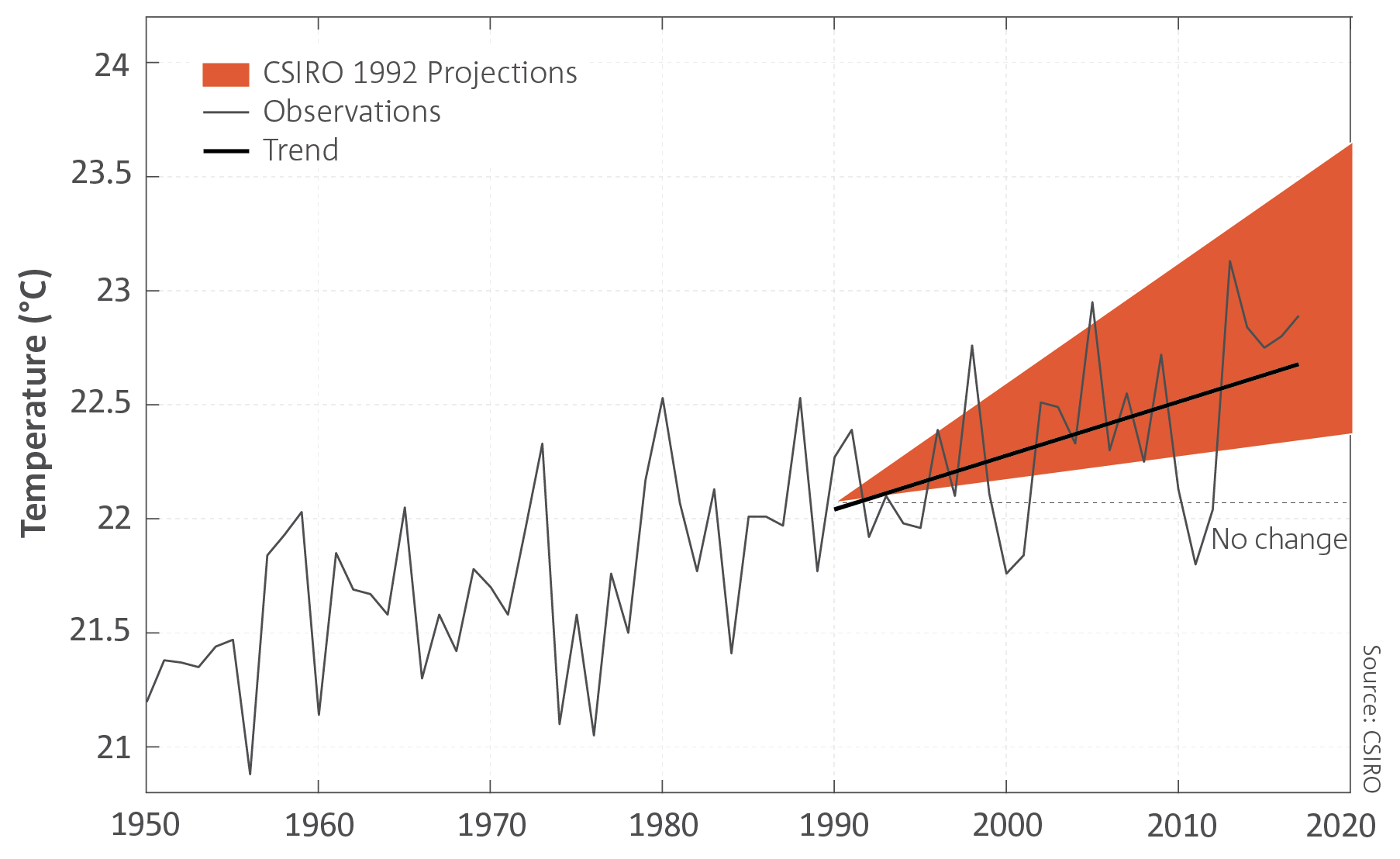Australia’s national climate projections at Climate change in Australia indicate that over coming decades Australia will experience:
- Further increase in temperatures, with more extremely hot days and fewer extremely cool days.
- Ongoing sea level rise.
- Further warming and acidification of the oceans around Australia.
- More frequent, extensive, intense and longer-lasting marine heatwaves, suggesting in turn more frequent and severe bleaching events on the Great Barrier Reef, and potentially the loss of many types of coral throughout the tropical reef systems of Australia and globally.
- A decrease in cool-season rainfall across many regions of southern Australia, with more time spent in drought.
- More intense heavy rainfall throughout Australia, particularly for short-duration extreme rainfall events.
- An increase in the number of high fire weather danger days and a longer fire season for southern and eastern Australia.
- Fewer tropical cyclones, but a greater proportion of high-intensity storms, with ongoing large variations from year to year.
Climate change will continue in the decades ahead, superimposed on natural variability. Changes in the climate, particularly in weather and climate extremes, can have a very significant impact on our environment and wellbeing, including on ecosystems, agriculture and the built environment.
Using our scientific understanding of the climate system, and advanced computer simulations, we can analyse the causes of past climate changes and explore projected future climate under differing scenarios of human emissions of greenhouse gases and aerosols. The amount of climate change expected in the next decade or so is similar under all plausible global emissions pathways. However, by the mid-21st Century, higher ongoing emissions of greenhouse gases will lead to greater warming and associated impacts, and reducing emissions will lead to less warming and fewer associated impacts.
Evaluation of previous temperature projections for Australia
It has now been almost 30 years since the first sets of climate model projections were published, providing the opportunity to compare those projections to observations of the actual climate. CSIRO (1992) produced projections of Australian temperature from 1990 to 2030 for Australia divided into three regions. Drawing the projections together as an Australian average, the linear trend in observed temperature has been tracking within this published range, and above ‘no change’. The fact that observations have been tracking within the envelope of projections builds confidence that climate models represent the key processes responsible for the warming trend and therefore these projections were a useful resource for future planning when they were released.
It should be noted that factors such as unforeseeable changes to the atmospheric composition and variability from influences such as specific El Niño and La Niña events mean that we can never make a forecast of the exact time series of Australian temperature, and that the projections will differ from observations over short to medium periods.

Australia’s national climate projections at Climate change in Australia indicate that over coming decades Australia will experience:
- Further increase in temperatures, with more extremely hot days and fewer extremely cool days.
- Ongoing sea level rise.
- Further warming and acidification of the oceans around Australia.
- More frequent, extensive, intense and longer-lasting marine heatwaves, suggesting in turn more frequent and severe bleaching events on the Great Barrier Reef, and potentially the loss of many types of coral throughout the tropical reef systems of Australia and globally.
- A decrease in cool-season rainfall across many regions of southern Australia, with more time spent in drought.
- More intense heavy rainfall throughout Australia, particularly for short-duration extreme rainfall events.
- An increase in the number of high fire weather danger days and a longer fire season for southern and eastern Australia.
- Fewer tropical cyclones, but a greater proportion of high-intensity storms, with ongoing large variations from year to year.
Climate change will continue in the decades ahead, superimposed on natural variability. Changes in the climate, particularly in weather and climate extremes, can have a very significant impact on our environment and wellbeing, including on ecosystems, agriculture and the built environment.
Using our scientific understanding of the climate system, and advanced computer simulations, we can analyse the causes of past climate changes and explore projected future climate under differing scenarios of human emissions of greenhouse gases and aerosols. The amount of climate change expected in the next decade or so is similar under all plausible global emissions pathways. However, by the mid-21st Century, higher ongoing emissions of greenhouse gases will lead to greater warming and associated impacts, and reducing emissions will lead to less warming and fewer associated impacts.
Evaluation of previous temperature projections for Australia
It has now been almost 30 years since the first sets of climate model projections were published, providing the opportunity to compare those projections to observations of the actual climate. CSIRO (1992) produced projections of Australian temperature from 1990 to 2030 for Australia divided into three regions. Drawing the projections together as an Australian average, the linear trend in observed temperature has been tracking within this published range, and above ‘no change’. The fact that observations have been tracking within the envelope of projections builds confidence that climate models represent the key processes responsible for the warming trend and therefore these projections were a useful resource for future planning when they were released.
It should be noted that factors such as unforeseeable changes to the atmospheric composition and variability from influences such as specific El Niño and La Niña events mean that we can never make a forecast of the exact time series of Australian temperature, and that the projections will differ from observations over short to medium periods.
